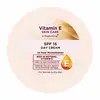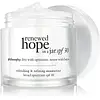What's inside
What's inside
 Key Ingredients
Key Ingredients

 Benefits
Benefits

 Concerns
Concerns

 Ingredients Side-by-side
Ingredients Side-by-side

Water
Skin ConditioningC12-15 Alkyl Benzoate
AntimicrobialEthylhexyl Methoxycinnamate
UV AbsorberButyl Methoxydibenzoylmethane
UV AbsorberGlycerin
HumectantGlyceryl Stearate Se
EmulsifyingGlyceryl Stearate
EmollientPEG-100 Stearate
Carbomer
Emulsion StabilisingPhenoxyethanol
PreservativeOctocrylene
UV AbsorberCetyl Alcohol
EmollientParaffin
PerfumingStearyl Alcohol
EmollientParfum
MaskingTocopheryl Acetate
AntioxidantDisodium EDTA
Sodium Hydroxide
BufferingEthylhexylglycerin
Skin ConditioningPentylene Glycol
Skin ConditioningPEG-35 Castor Oil
EmulsifyingSodium Citrate
BufferingAesculus Hippocastanum Seed Extract
Skin ConditioningAlcohol Denat.
Antimicrobial2-Bromo-2-Nitropropane-1,3-Diol
PreservativeLactic Acid
BufferingSerine
MaskingSodium Lactate
BufferingSorbitol
HumectantUrea
BufferingTocopherol
AntioxidantPolysorbate 20
EmulsifyingSodium Chloride
MaskingCalcium Pantothenate
Inositol
HumectantLinoleic Acid
CleansingRetinyl Palmitate
Skin ConditioningAllantoin
Skin ConditioningBiotin
AntiseborrhoeicLinalool
PerfumingCoumarin
PerfumingAlpha-Isomethyl Ionone
PerfumingWater, C12-15 Alkyl Benzoate, Ethylhexyl Methoxycinnamate, Butyl Methoxydibenzoylmethane, Glycerin, Glyceryl Stearate Se, Glyceryl Stearate, PEG-100 Stearate, Carbomer, Phenoxyethanol, Octocrylene, Cetyl Alcohol, Paraffin, Stearyl Alcohol, Parfum, Tocopheryl Acetate, Disodium EDTA, Sodium Hydroxide, Ethylhexylglycerin, Pentylene Glycol, PEG-35 Castor Oil, Sodium Citrate, Aesculus Hippocastanum Seed Extract, Alcohol Denat., 2-Bromo-2-Nitropropane-1,3-Diol, Lactic Acid, Serine, Sodium Lactate, Sorbitol, Urea, Tocopherol, Polysorbate 20, Sodium Chloride, Calcium Pantothenate, Inositol, Linoleic Acid, Retinyl Palmitate, Allantoin, Biotin, Linalool, Coumarin, Alpha-Isomethyl Ionone
Butyl Methoxydibenzoylmethane 2.7%
UV AbsorberEthylhexyl Methoxycinnamate 6.99%
UV AbsorberOctocrylene 2%
UV AbsorberWater
Skin ConditioningCarthamus Tinctorius Oleosomes
EmollientButylene Glycol
HumectantGlycerin
HumectantC12-15 Alkyl Benzoate
AntimicrobialMethyl Gluceth-20
HumectantGlycolic Acid
BufferingPolyacrylamide
Cyclopentasiloxane
EmollientAmmonium Acryloyldimethyltaurate/Vp Copolymer
Hydrogenated Lecithin
EmulsifyingCyclohexasiloxane
EmollientPhenoxyethanol
PreservativeSodium Hydroxide
BufferingC13-14 Isoparaffin
EmollientCetyl Alcohol
EmollientPolysorbate 80
EmulsifyingLaureth-7
EmulsifyingCitric Acid
BufferingParfum
MaskingCI 77163
Cosmetic ColorantMandelic Acid
AntimicrobialTocopheryl Acetate
AntioxidantDisodium EDTA
Synthetic Fluorphlogopite
Ethylhexyl Palmitate
EmollientPropanediol
SolventGluconic Acid
Adenosine
Skin ConditioningSodium Benzoate
MaskingBHT
AntioxidantEvodia Rutaecarpa Fruit Extract
Skin ConditioningSodium Bicarbonate
AbrasiveYeast Extract
Skin ConditioningMagnesium Stearate
Cosmetic ColorantOpuntia Coccinellifera Flower Extract
Skin ConditioningSilica Dimethyl Silylate
EmollientCaprylyl Glycol
EmollientEthylhexylglycerin
Skin ConditioningHyaluronic Acid
HumectantSilanetriol
Sodium Hyaluronate
HumectantSorbic Acid
PreservativeHexylene Glycol
EmulsifyingButyl Methoxydibenzoylmethane 2.7%, Ethylhexyl Methoxycinnamate 6.99%, Octocrylene 2%, Water, Carthamus Tinctorius Oleosomes, Butylene Glycol, Glycerin, C12-15 Alkyl Benzoate, Methyl Gluceth-20, Glycolic Acid, Polyacrylamide, Cyclopentasiloxane, Ammonium Acryloyldimethyltaurate/Vp Copolymer, Hydrogenated Lecithin, Cyclohexasiloxane, Phenoxyethanol, Sodium Hydroxide, C13-14 Isoparaffin, Cetyl Alcohol, Polysorbate 80, Laureth-7, Citric Acid, Parfum, CI 77163, Mandelic Acid, Tocopheryl Acetate, Disodium EDTA, Synthetic Fluorphlogopite, Ethylhexyl Palmitate, Propanediol, Gluconic Acid, Adenosine, Sodium Benzoate, BHT, Evodia Rutaecarpa Fruit Extract, Sodium Bicarbonate, Yeast Extract, Magnesium Stearate, Opuntia Coccinellifera Flower Extract, Silica Dimethyl Silylate, Caprylyl Glycol, Ethylhexylglycerin, Hyaluronic Acid, Silanetriol, Sodium Hyaluronate, Sorbic Acid, Hexylene Glycol
Ingredients Explained
These ingredients are found in both products.
Ingredients higher up in an ingredient list are typically present in a larger amount.
Also known as Avobenzone, this ingredient is a chemical sunscreen filter that provides protection in the UV-A range.
Avobenzone is globally approved and is the most commonly used UV-A filter in the world.
Studies have found that avobenzone becomes ineffective when exposed to UV light (it is not photostable; meaning that it breaks down in sunlight). Because of this, formulations that include avobenzone will usually contain stabilizers such as octocrylene.
However, some modern formulations (looking at you, EU!) are able to stabilize avobenzone by coating the molecules.
Avobenzone does not protect against the UV-B range, so it's important to check that the sunscreen you're using contains other UV filters that do!
The highest concentration of avobenzone permitted is 3% in the US, and 5% in the EU.
Learn more about Butyl MethoxydibenzoylmethaneC12-15 Alkyl Benzoate is made up of Benzoic Acid and long chain alcohols. It has a low molecular weight.
C12-15 Alkyl Benzoate is an emollient and texture enhancer. Due to its solubility, it is often used in sunscreens to help evenly distribute active ingredients.
As an emollient, C12-15 Alkyl Benzoate helps soften and hydrate your skin. Emollients create a film on your skin that traps moisture within.
This ingredient has been reported to cause eye irritation.
Learn more about C12-15 Alkyl BenzoateCetyl Alcohol is a fatty alcohol. Fatty Alcohols are most often used as an emollient or to thicken a product.
Its main roles are:
Though it has "alcohol" in the name, it is not related to denatured alcohol or ethyl alcohol.
The FDA allows products labeled "alcohol-free" to have fatty alcohols.
Learn more about Cetyl AlcoholDisodium EDTA plays a role in making products more stable by aiding other preservatives.
It is a chelating agent, meaning it neutralizes metal ions that may be found in a product.
Disodium EDTA is a salt of edetic acid and is found to be safe in cosmetic ingredients.
Learn more about Disodium EDTAEthylhexyl Methoxycinnamate is an organic compound that provides UVB protection. It often goes by the more common name of octinoxate. It is created from methoxycinnamic acid and 2-ethylhexanol.
Ethylhexyl Methoxycinnamate absorbs UVB rays with wavelengths between 280-320 nm. UV absorbers protect your skin by using chemical reactions to convert UV rays into heat and energy.
UVB (290-320 nm) rays emit more energy than UVA rays. They are capable of damaging DNA, causing sunburns and are thought to be linked to skin cancer.
The state of Hawaii has banned sunscreens containing octinoxate due to its potential impact on coral reefs. More research is needed to bridge gaps in this research. The European Union allows higher levels of octinoxate in sunscreens than the US and Australia.
Ethylhexyl Methoxycinnamate is oil soluble. It is not stable and may lose efficacy when exposed to sunlight.
Learn more about Ethylhexyl MethoxycinnamateEthylhexylglycerin (we can't pronounce this either) is commonly used as a preservative and skin softener. It is derived from glyceryl.
You might see Ethylhexylglycerin often paired with other preservatives such as phenoxyethanol. Ethylhexylglycerin has been found to increase the effectiveness of these other preservatives.
Glycerin is already naturally found in your skin. It helps moisturize and protect your skin.
A study from 2016 found glycerin to be more effective as a humectant than AHAs and hyaluronic acid.
As a humectant, it helps the skin stay hydrated by pulling moisture to your skin. The low molecular weight of glycerin allows it to pull moisture into the deeper layers of your skin.
Hydrated skin improves your skin barrier; Your skin barrier helps protect against irritants and bacteria.
Glycerin has also been found to have antimicrobial and antiviral properties. Due to these properties, glycerin is often used in wound and burn treatments.
In cosmetics, glycerin is usually derived from plants such as soybean or palm. However, it can also be sourced from animals, such as tallow or animal fat.
This ingredient is organic, colorless, odorless, and non-toxic.
Glycerin is the name for this ingredient in American English. British English uses Glycerol/Glycerine.
Learn more about GlycerinOctocrylene protects skin from sun damage. It absorbs UV-B with peak absorption of 304 nm. It is a common sunscreen ingredient and often paired with avobenzone, a UVA filter. This is because octocrylene stabilizes other sunscreen ingredients by protecting them from degradation when exposed to sunlight. Octocrylene is a photostable ingredient and loses about 10% of SPF in 95 minutes.
Octocrylene also acts as an emollient, meaning it helps skin retain moisture and softens skin. It is oil-soluble and hydrophobic, enhancing water-resistant properties in a product.
Those who are using ketoprofen, a topical anti-inflammatory drug, may experience an allergic reaction when using octocrylene. It is best to speak with a healthcare professional about using sunscreens with octocrylene.
The EU allows a maximum of these concentrations:
Learn more about OctocryleneParfum is a catch-all term for an ingredient or more that is used to give a scent to products.
Also called "fragrance", this ingredient can be a blend of hundreds of chemicals or plant oils. This means every product with "fragrance" or "parfum" in the ingredients list is a different mixture.
For instance, Habanolide is a proprietary trade name for a specific aroma chemical. When used as a fragrance ingredient in cosmetics, most aroma chemicals fall under the broad labeling category of “FRAGRANCE” or “PARFUM” according to EU and US regulations.
The term 'parfum' or 'fragrance' is not regulated in many countries. In many cases, it is up to the brand to define this term.
For instance, many brands choose to label themselves as "fragrance-free" because they are not using synthetic fragrances. However, their products may still contain ingredients such as essential oils that are considered a fragrance by INCI standards.
One example is Calendula flower extract. Calendula is an essential oil that still imparts a scent or 'fragrance'.
Depending on the blend, the ingredients in the mixture can cause allergies and sensitivities on the skin. Some ingredients that are known EU allergens include linalool and citronellol.
Parfum can also be used to mask or cover an unpleasant scent.
The bottom line is: not all fragrances/parfum/ingredients are created equally. If you are worried about fragrances, we recommend taking a closer look at an ingredient. And of course, we always recommend speaking with a professional.
Learn more about ParfumPhenoxyethanol is a preservative that has germicide, antimicrobial, and aromatic properties. Studies show that phenoxyethanol can prevent microbial growth. By itself, it has a scent that is similar to that of a rose.
It's often used in formulations along with Caprylyl Glycol to preserve the shelf life of products.
Sodium Hydroxide is also known as lye or caustic soda. It is used to adjust the pH of products; many ingredients require a specific pH to be effective.
In small amounts, sodium hydroxide is considered safe to use. However, large amounts may cause chemical burns due to its high alkaline.
Your skin has a natural pH and acid mantle. This acid mantle helps prevent harmful bacteria from breaking through. The acid mantle also helps keep your skin hydrated.
"Alkaline" refers to a high pH level. A low pH level would be considered acidic.
Learn more about Sodium HydroxideTocopheryl Acetate is AKA Vitamin E. It is an antioxidant and protects your skin from free radicals. Free radicals damage the skin by breaking down collagen.
One study found using Tocopheryl Acetate with Vitamin C decreased the number of sunburned cells.
Tocopheryl Acetate is commonly found in both skincare and dietary supplements.
Learn more about Tocopheryl AcetateWater. It's the most common cosmetic ingredient of all. You'll usually see it at the top of ingredient lists, meaning that it makes up the largest part of the product.
So why is it so popular? Water most often acts as a solvent - this means that it helps dissolve other ingredients into the formulation.
You'll also recognize water as that liquid we all need to stay alive. If you see this, drink a glass of water. Stay hydrated!
Learn more about Water